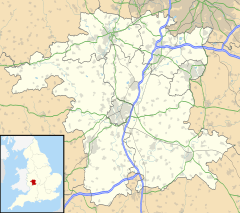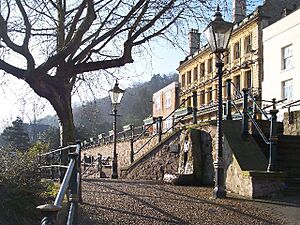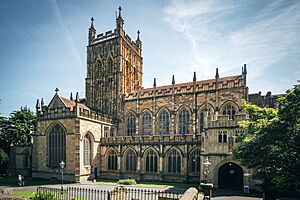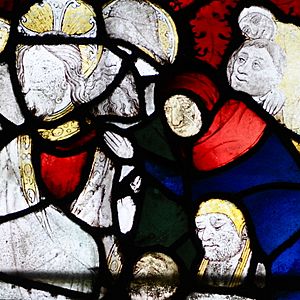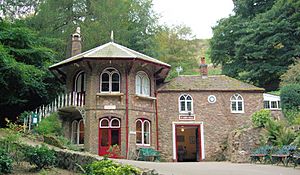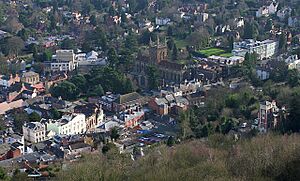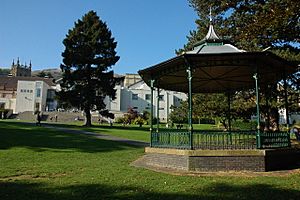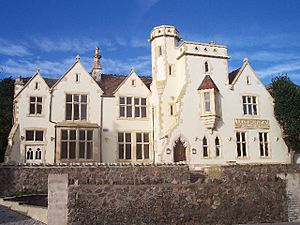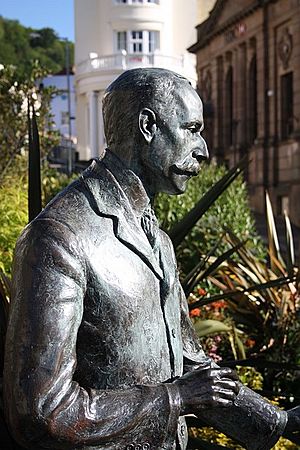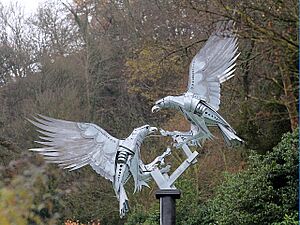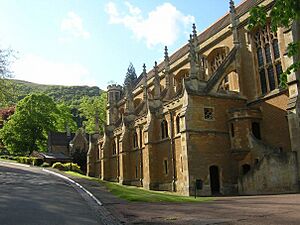Great Malvern facts for kids
Quick facts for kids Great Malvern |
|
|---|---|
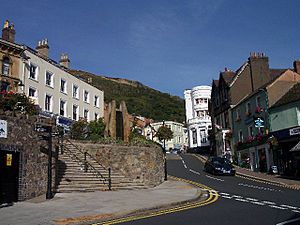 View of the junction of Church Street and Bellevue Terrace, with North Hill in background, and the Elgar Enigma statue to the left. |
|
| OS grid reference | SO786459 |
| Civil parish | |
| District |
|
| Shire county | |
| Region | |
| Country | England |
| Sovereign state | United Kingdom |
| Post town | MALVERN |
| Postcode district | WR14 |
| Dialling code | 01684 |
| Police | West Mercia |
| Fire | Hereford and Worcester |
| Ambulance | West Midlands |
| EU Parliament | West Midlands |
| UK Parliament |
|
Great Malvern is a lovely area in Malvern, England. It sits right at the bottom of the beautiful Malvern Hills. These hills are a special place known for their natural beauty. Great Malvern is the old heart of the town and includes its main shopping area.
This area is officially a "conservation area." This means its special buildings and history are protected. Great Malvern started growing when a priory (a type of monastery) was built there in the 11th century. In the 1800s, it became famous for its healing waters. People came for hydrotherapy, which is therapy using water. The town grew to include nearby areas like Barnards Green and Malvern Link. All these areas, plus the hills, are often called The Malverns.
Great Malvern is also an important place for local government. It's where the Malvern Town Council and other local offices are located. You'll find many of the town's main facilities here. These include the Malvern Theatres, Priory Park, a swimming pool, the main library, and the tourist information centre.
Contents
Where is Great Malvern Located?
Great Malvern is about 8 miles (13 km) southwest of the city of Worcester. It's built on the eastern slopes of the Malvern Hills. The town's height above sea level ranges from about 164 to 656 feet (50 to 200 metres). The River Severn flows about 4 miles (6 km) to the east of the town.
Belle Vue Island is a public garden in the town centre. It's the end point for the Worcestershire Way. This is a long walking trail that stretches 31 miles (50 km) from Bewdley to Great Malvern.
Exploring the Town Centre
The town centre has two main streets that cross each other. Church Street is quite steep, while Bellevue Terrace is flatter. In the middle of town, you'll see a statue of the famous composer Edward Elgar. There are also statues celebrating Malvern's famous water.
You'll find many shops in the town centre. There are two large supermarkets and traditional shops like butchers and bakers. You can also visit cafés, bookshops, art galleries, and antique shops. The public library offers many community services. The Victorian Great Malvern railway station is a beautiful old building. It's close to the former Imperial Hotel, which was designed by the same architect.
Many old, tall trees grow in Great Malvern. In the 1800s, when Lady Foley sold parts of her land, she made sure that trees were planted around the town centre.
A Look at Malvern's History
How the Priory Shaped Malvern
The town of Malvern grew around its 11th-century priory. This was a Benedictine monastery. Parts of the old monastery are now part of Great Malvern Priory, which is a large church today.
There are different stories about how the religious community started. One legend says that a monk named St. Werstan fled to the Malvern Hills. He found a safe place and built a small hermitage near St. Ann's Well. Historians believe St. Werstan was the first martyr (someone who dies for their beliefs) connected to the area.
The first leader of the monastery was Aldwyn of Malvern. He started the monastery in 1085. By 1135, there were thirty monks living there. An old stained glass window in the Priory church shows the story of St. Werstan. It also shows Edward the Confessor granting land for the monastery.
Important people like Gilbert de Clare, 7th Earl of Gloucester gave gifts to the Priory in the 1200s. The Priory was also important for developing stained glass art. In the 1400s and 1500s, Malvern was a well-known place. Even King Henry VII and his family admired Malvern and gave money to the Priory.
After the Monasteries Closed

During the time when King Henry VIII closed down monasteries (the Dissolution of the Monasteries), Malvern Priory was saved. Local people bought it to use as their parish church. Much of its beautiful 15th-century stained glass was also saved.
Most of the monastery buildings were taken apart and sold. Today, apart from the church itself, the only part left of the monastery is the Abbey Gateway. This old gateway now houses the Malvern Museum.
Malvern as a Spa Town (17th–19th Centuries)
Malvern became famous as a spa town because of its special water and beautiful scenery. People came seeking cures, rest, and entertainment. Local stories say the healing power of Malvern water was known long ago.
In 1756, Dr. John Wall wrote a pamphlet about the benefits of Malvern water. Other famous people, like the botanist Benjamin Stillingfleet and the poet Thomas Warton, also praised it. In 1828, Dr. William Addison, a doctor to the mother of Queen Victoria, spoke about Malvern's "pure and invigorating air" and "romantic beauty."
People started bottling and shipping Malvern water. In 1842, two doctors, James Wilson and James Manby Gully, opened clinics in Malvern. They specialized in hydrotherapy, which uses water for health. Malvern quickly grew as a spa town. Many large hotels and villas (big houses) were built during this time. By 1865, over a quarter of the town's houses were used for guests.
Queen Adelaide visited St. Ann's Well in 1842. Many famous visitors came to Malvern in the 1840s and 1850s. These included Charles Darwin, Florence Nightingale, and Lord Tennyson.
The railway came to Malvern in 1859. This made it much easier for people to visit. In 1860, 10,000 people came from the Black Country (an industrial area) for day trips. Factories even organized trips for their workers. The railway also brought coal, making Malvern a popular winter resort.
By the late 1800s, hydrotherapy became less popular. Many hotels were turned into private boarding schools. Education then became a big part of Malvern's economy. By 1885, the town had 25 private schools. The area was perfect for schools because of its nice environment and easy train access.
Local Government in Great Malvern
In 1900, the areas of Great Malvern and Malvern Link joined together. This area now forms the civil parish of Malvern, which has a town council. The Malvern Town Council is based in Great Malvern.
Other local government bodies that cover Great Malvern include the Malvern Hills District Council (also based in Great Malvern) and the Worcestershire County Council.
Culture and Fun in Great Malvern
Priory Park is a large green space in the town centre. Next to it are the Malvern Splash pool and the Winter Gardens. The Winter Gardens complex is home to the Malvern Theatre. This is a major centre for plays, films, and concerts.
The Malvern Winter Gardens has hosted many classical music concerts. It has also seen performances by famous rock bands from the 1960s, 70s, and 80s. The Splash Leisure Complex has an indoor swimming pool and a gym.
The Manor Park Club offers many indoor and outdoor sports facilities for the Malvern area.
Drama and Theatre
Malvern Theatres are located in the Winter Gardens complex. They are a very important place for the arts in the region. The first Malvern Drama Festival was held in 1929. It was dedicated to the famous playwright George Bernard Shaw. Many new plays have been performed for the first time in Malvern.
In 1998, the theatre had a big renovation, costing £7.2 million. This was helped by money from the National Lottery.
The The Theatre of Small Convenience is the smallest theatre in the world! It's in a former Victorian public toilet in Edith Walk. It can only hold 12 people. This tiny theatre hosts puppetry, plays, poetry, and opera. Famous actors like Simon Callow have even performed there.
Literature and Stories
The famous 14th-century poem The Visions of Piers Plowman was inspired by the Malvern Hills. Its earliest line about the hills is "And on a Maye mornynge on Malverne hylles."
Authors C. S. Lewis and J. R. R. Tolkien often visited Malvern. A legend says that one snowy evening, after leaving a Malvern pub, they saw a lamp post shining through the snow. Lewis supposedly said, "that would make a very nice opening line to a book." This image later appeared in his book The Lion, the Witch and the Wardrobe, as characters enter Narnia.
J.R.R. Tolkien found inspiration in the Malvern landscape. He was introduced to the area by C. S. Lewis. Tolkien would walk the Malvern Hills and compare parts of them to the White Mountains of Gondor from his The Lord of the Rings books. Recordings of Tolkien reading from The Hobbit and The Lord of the Rings were even made in Malvern in 1952.
Architecture and Buildings
Great Malvern was named a Conservation Area in 1969. This is because of its special architecture. You can see many styles, including Victorian, Regency, and Gothic Revival. Many houses were built during the Industrial Revolution when Malvern was a popular spa town. Wealthy families from Birmingham built them.
When the spa industry declined, many hotels and large villas became schools. Some have since been turned into apartments or retirement homes. The Imperial Hotel, built in 1860, is one of Malvern's largest buildings. It was the first hotel to be lit by incandescent gas.
Many buildings and statues in the town centre celebrate Malvern water. This includes St Ann's Well, which has a building from 1813. The Malvhina drinking spout, a sculpture by Rose Garrard, was unveiled in 1998. The Enigma Fountain, also by Garrard, was unveiled by The Duke of York in 2000.
Music and Composers
Sir Edward Elgar, a famous British composer, lived much of his life near Malvern. He is buried in a nearby churchyard. A sculpture group by Rose Garrard includes the Enigma fountain and a statue of Elgar. It stands in the town centre. The Elgar Route is a 40-mile (64 km) drive that passes key places from Elgar's life.
The Malvern Concert Club, started by Elgar in 1903, holds concerts at the Malvern Theatres. They play classical music from different periods.
In the 1960s, 70s, and 80s, the Malvern Winter Gardens was a popular place for rock concerts. Bands like T-Rex, The Jam, and AC/DC played there.
The Chandos Symphony Orchestra has over 100 players. They perform large musical works from the 19th and 20th centuries. The Autumn in Malvern Festival is an annual event in October. It features music, poetry, and films. The opera singer Jenny Lind lived and died in Malvern. She is buried in Great Malvern cemetery.
The Malvern Fringe Festival started in 1977. It offers a different kind of music and art compared to the main Malvern Festival. It takes place over three days in June. The Fringe also organizes the Malvern May Day and Parade, a community event held in Priory Park since 1993.
Art in Malvern
Great Malvern has many artworks, including fountains, statues, and water spouts. Many are by the sculptor Rose Garrard. Her works include the statue of Sir Edward Elgar and the Enigma Fountain. She also created the Malvhina drinking spout.
A sculpture of two buzzards by Walenty Pytel was placed in Rosebank Gardens in 2012. It celebrates the Queen's Diamond Jubilee.
Paintings of Great Malvern include Joseph Powell's Great Malvern Priory (1797) and J. M. W. Turner's Porch of Great Malvern Abbey.
Malvern on Television
The film Elgar, a documentary about the composer, was filmed in Malvern in 1962. Scenes were shot at the Bluebird Tea Rooms and St Ann's Well. This film helped make Elgar more famous.
Great Malvern railway station was featured in the 1975 TV series Survivors (1975 TV series). This was a drama about a world after a disaster.
Education in Great Malvern
In the late 1800s and early 1900s, many private boarding schools opened in Great Malvern. They often took over old hotels and large houses. Today, two large independent schools remain: Malvern College and Malvern St James.
Malvern College is a school for both boys and girls. It was founded in 1865. It now teaches students from 3 to 18 years old. Many famous people have attended Malvern College, including Nobel Prize winners and Olympic athletes.
Malvern St James is a girls' school. It was formed in 2006 by combining several local private schools. Its main building is the former Imperial Hotel.
There are also several primary schools in the Great Malvern area. Secondary schools for the area are located in nearby suburbs and villages.
Getting Around Great Malvern
By Train
Great Malvern railway station is a short walk downhill from the town centre. You can catch direct trains to Worcester, Hereford, Birmingham, Oxford, and London.
By Bus
Local bus services connect Great Malvern to the surrounding areas.
By Air
The closest major airport is Birmingham Airport. It's about an hour away by car. Gloucestershire Airport is a smaller airport nearby. It's mainly used for private flights and pilot training.
Famous People from Great Malvern

- Robert Conquest (1917–2015): A historian born in Great Malvern.
- Anne Darwin: The daughter of Charles Darwin, buried in Malvern Priory graveyard.
- Edward Elgar: The famous composer, who taught in Great Malvern.
- Haile Selassie: The emperor of Ethiopia, who stayed at the Abbey Hotel during his exile.
- Jenny Lind: An opera singer who lived and died in Malvern.
- Franklin D. Roosevelt: Later President of the USA, who stayed in Great Malvern as a child.
- Cher Lloyd: A singer born and raised in Malvern.
- Jacqui Smith: A former government minister, born and living in Malvern.
See also
 In Spanish: Great Malvern para niños
In Spanish: Great Malvern para niños


